How to fix error code 0x800701B1 on Windows 10/11
When transferring files from a drive to another driver in File Explorer, you may encounter this error message stating "Error x800701B1: A non-existent device was specified ". While many users have reported this issue while copy-pasting large files on USB devices, a few of them have also encountered this issue while trying to install Windows on HDD/SSD connected to a USB port.
Fix 1 – Plug the drive into another port
As you know, there are several types of ports on your system. However, some newer external SSDs/HDDs only work with USB 3.0. Therefore, if you have plugged into a USB 2.0 port, you may get this error.
1. You have to eject the USB drive. So, click on the arrow icon to view hidden system icons.
2. Here, look for the USB eject icon. Now, click once to view all USB connected to the system.
3. Now, just right-click on the external drive and click "Eject" to safely eject the drive.
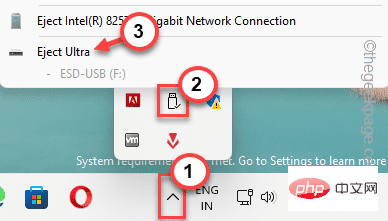
#4. Simply unplug the device from the existing USB port.
5. Then, take a closer look at the USB ports on your PC/Laptop. You'll find USB 3.0 ports on all the latest laptops. And if you're on a PC, there are several USB ports on the back.
6. Plug the USB drive into a new port on the machine.
Then, test it by transferring some files from the drive to the computer and vice versa. Check to see if you still see error code0x800701B1.
Fix 2 – Rescan the entire drive
Try rescanning the drive from Disk Management to resolve the issue.
1. You can use the disk management tool to rescan the drive.
2. Press Win key and X key to open the context menu.
3. Then, click the "Disk Management" tool to open it.
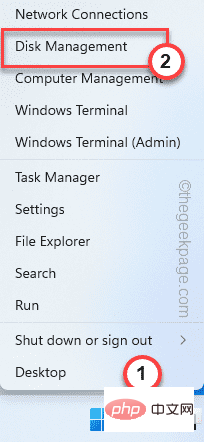
#4. In the Disk Management tool, you can view the complete list of drives in the main pane.
5. Simply click the "Action" menu and then click "Rescan Disk" to rescan the drive.
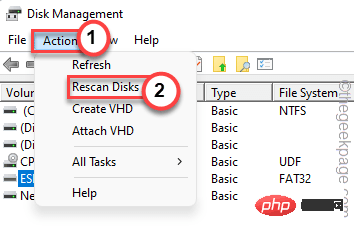
After rescanning the drive, you can close the Disk Management tool. After that, try copy-pasting or transferring the file.
You will no longer see the error message.
Fix 3 – Own the drive in question
If you do not have the appropriate permissions for the drive, you will need to grant sufficient permissions to it.
1. First, open File Explorer by pressing the Win key and the E key together.
2. Now, click on “This PC” in the left pane.
3. Find the drive here. Now, right-click on the drive and click on "Properties".
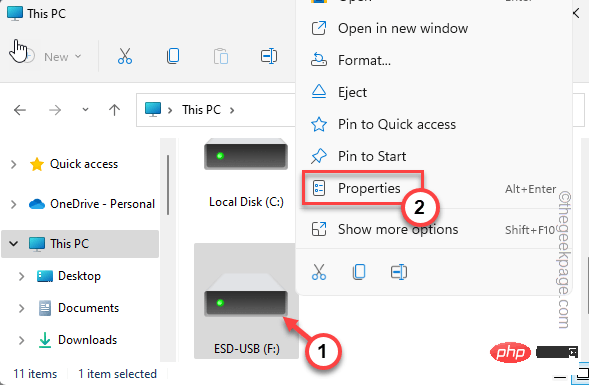
4. After that, right click on the drive and go to the "Security" tab.
5. Here, in this tab, click Advanced to open Advanced security settings.

5. Next, next to the "Owner:" option, click "Change".

6. On the next screen, click on the “Advanced” option.
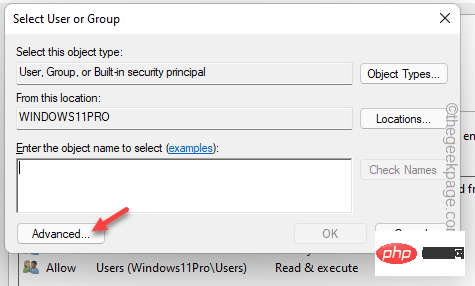
#7. Later, click the "Find Now" button to find the complete list of user groups.
8. Within these groups, select your username and double-click the username.
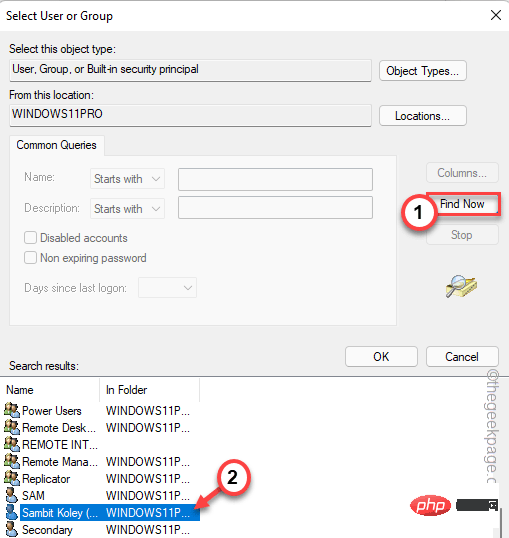
9. To confirm this, click "OK".
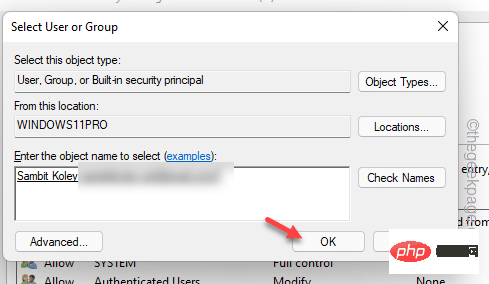
10. After returning to the homepage, select"Replace all child object permission entries with the inheritable permission entries of this object "frame.
11. Then, to save the changes, click "Apply" and "OK".

Now, try transferring the file you tried earlier.
Fix 4 – Uninstall and reinstall the disk drive
Uninstall and reinstall the disk drive on your computer.
1. First, press the win key and the R key.
2. Then, enter this and click Enter.
devmgmt.msc

3. On the Device Manager page, Expand the "Disk Drive" drop-down list.
4. Here, just right-click on the disk drive and click on "Uninstall Device".
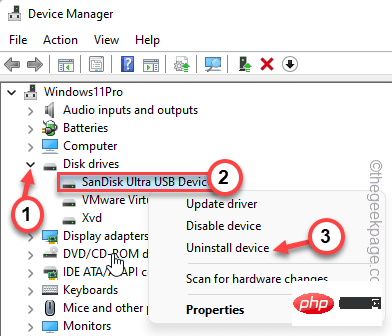
5. Confirm the uninstallation again. Click "Uninstall" again.
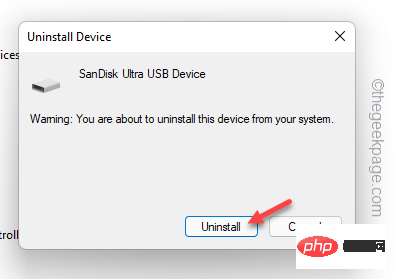
This way, the disk drive is unmounted from the computer. Don't worry. This will only uninstall the current driver.
Restart the computer. This way, Windows will indeed replace the uninstalled driver with the default driver. After restarting, you can easily transfer files without any issues.
The above is the detailed content of How to fix error code 0x800701B1 on Windows 10/11. For more information, please follow other related articles on the PHP Chinese website!

Hot AI Tools

Undresser.AI Undress
AI-powered app for creating realistic nude photos

AI Clothes Remover
Online AI tool for removing clothes from photos.

Undress AI Tool
Undress images for free

Clothoff.io
AI clothes remover

Video Face Swap
Swap faces in any video effortlessly with our completely free AI face swap tool!

Hot Article

Hot Tools

Notepad++7.3.1
Easy-to-use and free code editor

SublimeText3 Chinese version
Chinese version, very easy to use

Zend Studio 13.0.1
Powerful PHP integrated development environment

Dreamweaver CS6
Visual web development tools

SublimeText3 Mac version
God-level code editing software (SublimeText3)

Hot Topics
 1653
1653
 14
14
 1413
1413
 52
52
 1304
1304
 25
25
 1251
1251
 29
29
 1224
1224
 24
24
 What is the reason why PS keeps showing loading?
Apr 06, 2025 pm 06:39 PM
What is the reason why PS keeps showing loading?
Apr 06, 2025 pm 06:39 PM
PS "Loading" problems are caused by resource access or processing problems: hard disk reading speed is slow or bad: Use CrystalDiskInfo to check the hard disk health and replace the problematic hard disk. Insufficient memory: Upgrade memory to meet PS's needs for high-resolution images and complex layer processing. Graphics card drivers are outdated or corrupted: Update the drivers to optimize communication between the PS and the graphics card. File paths are too long or file names have special characters: use short paths and avoid special characters. PS's own problem: Reinstall or repair the PS installer.
 How to solve the problem of loading when PS is always showing that it is loading?
Apr 06, 2025 pm 06:30 PM
How to solve the problem of loading when PS is always showing that it is loading?
Apr 06, 2025 pm 06:30 PM
PS card is "Loading"? Solutions include: checking the computer configuration (memory, hard disk, processor), cleaning hard disk fragmentation, updating the graphics card driver, adjusting PS settings, reinstalling PS, and developing good programming habits.
 How to speed up the loading speed of PS?
Apr 06, 2025 pm 06:27 PM
How to speed up the loading speed of PS?
Apr 06, 2025 pm 06:27 PM
Solving the problem of slow Photoshop startup requires a multi-pronged approach, including: upgrading hardware (memory, solid-state drive, CPU); uninstalling outdated or incompatible plug-ins; cleaning up system garbage and excessive background programs regularly; closing irrelevant programs with caution; avoiding opening a large number of files during startup.
 Is slow PS loading related to computer configuration?
Apr 06, 2025 pm 06:24 PM
Is slow PS loading related to computer configuration?
Apr 06, 2025 pm 06:24 PM
The reason for slow PS loading is the combined impact of hardware (CPU, memory, hard disk, graphics card) and software (system, background program). Solutions include: upgrading hardware (especially replacing solid-state drives), optimizing software (cleaning up system garbage, updating drivers, checking PS settings), and processing PS files. Regular computer maintenance can also help improve PS running speed.
 How to set color mode for export PDF on PS
Apr 06, 2025 pm 05:09 PM
How to set color mode for export PDF on PS
Apr 06, 2025 pm 05:09 PM
The secret to export PDFs with accurate colors: choose color mode according to the purpose: RGB for network display, CMYK for professional printing. Check Embed Profiles when exporting to maintain color consistency. Adjust compression settings to balance image quality and file size. For PDFs for networks, use RGB mode; for PDFs for printing, use CMYK mode.
 Does mysql need the internet
Apr 08, 2025 pm 02:18 PM
Does mysql need the internet
Apr 08, 2025 pm 02:18 PM
MySQL can run without network connections for basic data storage and management. However, network connection is required for interaction with other systems, remote access, or using advanced features such as replication and clustering. Additionally, security measures (such as firewalls), performance optimization (choose the right network connection), and data backup are critical to connecting to the Internet.
 Is PS slow loading related to other programs that are running?
Apr 06, 2025 pm 06:03 PM
Is PS slow loading related to other programs that are running?
Apr 06, 2025 pm 06:03 PM
The secrets to mastering Office software include: understanding different versions and platforms, correctly installing and configuring, proficient in using the software interface, in-depth understanding of feature operations, application collaboration and sharing functions, utilizing templates and styles, mastering advanced skills, and solving common problems. In addition, you need to choose a version that suits your needs, make good use of templates and styles, develop backup habits, and learn shortcut keys and advanced techniques to improve efficiency.
 How to solve the problem of loading when the PS opens the file?
Apr 06, 2025 pm 06:33 PM
How to solve the problem of loading when the PS opens the file?
Apr 06, 2025 pm 06:33 PM
"Loading" stuttering occurs when opening a file on PS. The reasons may include: too large or corrupted file, insufficient memory, slow hard disk speed, graphics card driver problems, PS version or plug-in conflicts. The solutions are: check file size and integrity, increase memory, upgrade hard disk, update graphics card driver, uninstall or disable suspicious plug-ins, and reinstall PS. This problem can be effectively solved by gradually checking and making good use of PS performance settings and developing good file management habits.



